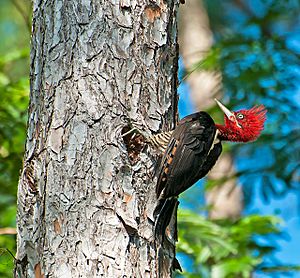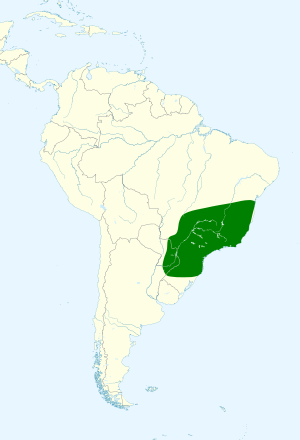Robust woodpecker facts for kids
Quick facts for kids Robust woodpecker |
|
|---|---|
 |
|
| Conservation status | |
| Scientific classification | |
| Genus: |
Campephilus
|
| Species: |
robustus
|
 |
|
The robust woodpecker (Campephilus robustus) is a type of bird that belongs to the woodpecker family. You can find this bird in parts of Argentina, Brazil, and Paraguay. It's known for its strong pecking and unique calls.
Contents
Understanding the Robust Woodpecker
What's in a Name? (Taxonomy)
Scientists group living things to understand them better. This is called taxonomy. For a while, the robust woodpecker was placed in different groups, but now it's part of the Campephilus group. This bird is also "monotypic," which means it's the only species in its specific group, with no different subspecies.
What Does It Look Like? (Description)
The robust woodpecker is a medium-sized bird, about 32 to 37 centimeters (12.6 to 14.6 inches) long. It weighs between 230 and 294 grams (8.1 to 10.4 ounces).
Here are some cool facts about its looks:
- Its upper body is mostly whitish, sometimes with a light creamy or cinnamon color.
- Its shoulder feathers and the top of its wings are black. They have small rusty-buff spots on the inner parts of the flight feathers.
- The underside of its wings is dark brownish-black with reddish-buff spots.
- Its tail is black.
- Its belly is creamy to whitish-cream with black stripes. These stripes are thinner on its lower belly.
Male and female robust woodpeckers look a bit different:
- Adult males have a completely red head and neck. They also have a small black and white spot near their ears.
- Adult females do not have this ear spot. Instead, they have a wide whitish stripe with black edges that goes from their beak to their ears.
Both male and female adults have a long, chisel-shaped beak that is horn-colored. Their eyes are white to yellow-white, and their legs are dark gray. Young woodpeckers look similar to adults but are usually duller and browner.
Where Does It Live? (Distribution and Habitat)
The robust woodpecker lives in eastern Brazil, eastern Paraguay, and northeastern Argentina. It prefers to live in healthy, moist forests, especially those with Araucaria trees. It usually avoids forests that have been disturbed unless there are still many large trees left. You can find these birds from sea level up to 2,200 meters (7,200 feet) high in the mountains.
How the Robust Woodpecker Behaves
Staying in One Place (Movement)
These woodpeckers don't migrate. They stay in the same areas all year round.
What Does It Eat? (Feeding)
The robust woodpecker searches for food at all levels of the forest, but it especially likes the middle parts of trees. It rarely looks for food on the ground. It mostly hunts on tree trunks and the bases of large branches. It pecks and hammers hard to find food. It also probes into cracks and peels off bark.
They usually look for food alone, in pairs, or in family groups. They don't often join other bird species when they are feeding. Their diet mainly consists of adult beetles and beetle larvae, but they also eat some berries.
Starting a Family (Reproduction)
Not much is known about how robust woodpeckers raise their young. One nest was seen being built in May, and it had young birds in July. Scientists are still learning more about their breeding habits.
Sounds They Make (Vocal and Non-vocal)
The robust woodpecker makes several interesting sounds:
- One call sounds like "psó-ko po-po-po-po-rrat."
- They also make "kee" and "kew" calls, both when flying and when sitting on a branch.
- Their drumming sound is a double tap, like "to-plóp" or "thump-ump."
Protecting the Robust Woodpecker (Status)
The IUCN (International Union for Conservation of Nature) has listed the robust woodpecker as a species of "Least Concern." This means that, for now, it's not considered to be in danger of disappearing.
Even though its home range is somewhat small and we don't know exactly how many there are, the population seems to be growing. There are no immediate threats to this bird right now. It lives in many national parks and protected areas. However, experts believe it is very sensitive to forests being broken up into smaller pieces. More research is needed to understand its life and how it reproduces.
See also
 In Spanish: Picamaderos robusto para niños
In Spanish: Picamaderos robusto para niños


